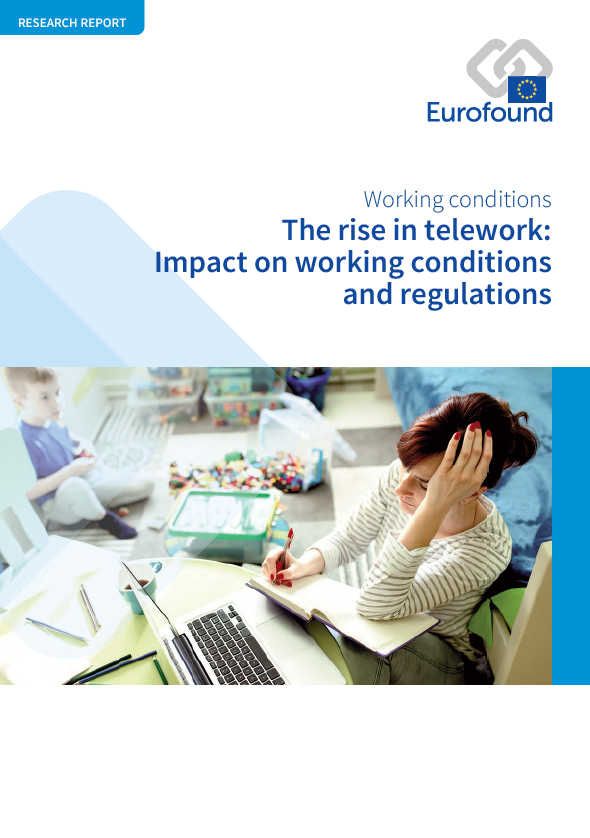
Šajā ziņojumā ir izklāstīts Eurofound pētījums par tāldarbu Covid-19 pandēmijas laikā 2020.–2021. gadā. Tajā ir pētītas tāldarba biežuma, darba apstākļu izmaiņas, ar kādām saskārās darbinieki, strādājot no mājām, un izmaiņas noteikumos attiecībā uz jautājumiem, kas saistīti ar šo darba režīmu. Konstatējumos atklājas pandēmijas izraisīta strauja tāldarba eskalācija – divi no 10 Eiropas darbiniekiem 2021. gadā strādāja tāldarbu. Šis skaitlis, visticamāk, nebūtu sasniegts pirms 2027. gada, ja nebijis pandēmijas. Veselības krīze atraisīja sociālo un tehnoloģisko potenciālu elastīgumam darba laika un vietas ziņā. Tāldarba ietekmi uz darba apstākļiem sākotnēji bija grūti noteikt, jo to bija grūti nodalīt no pandēmijas izraisītiem faktoriem, piemēram, mājsēdes un skolu slēgšanas. Tomēr ir kļuvusi acīmredzamāka gan pozitīvā ietekme, piemēram, tāldarba ieguldījums darba un privātās dzīves līdzsvara uzlabošanā, gan negatīvā ietekme, piemēram, sociālās mijiedarbības samazināšanās un nostrādāto virsstundu skaita pieaugums. Tāldarba pieaugums un izpratne par tā ietekmi uz darba apstākļiem ir likusi no jauna koncentrēties uz tiesisko regulējumu, jo vairākās ES dalībvalstīs ir pieņemti jauni tāldarba noteikumi.
Key findings
Tāldarbs joprojām saglabāsies. Jauni konstatējumi liecina, ka 2021. gadā visā ES tāldarbu strādāja 41,7 miljoni darbinieku, un tas apstiprina tāldarbinieku skaita divkāršošanos kopš 2019. gada. Lai gan 2022. gadā bija vērojams neliels samazinājums, paredzams, ka šī augšupējā tendence atsāksies, jo tehnoloģiju attīstība palielina tāldarba darbvietu skaitu un darbinieku un darba devēju vēlmes vairāk nosliecas uz attālinātu darbu.
Pandēmija apliecināja tāldarba milzīgo potenciālu, uzlabojot darbinieku dzīves un darba apstākļus, kā arī ļaujot viņiem līdzsvarot savu darba laiku ar privāto un ģimenes dzīvi. Darbiniekiem arī vajadzēja mazāk laika svārstsatiksmei, un viņi izjuta lielāku darba autonomiju un elastību bez negatīvas ietekmes uz darba ražīgumu darbavietā.
Tāldarba izplatību ne vienmēr ietekmē dzimums, lai gan tāldarbu strādā mazliet vairāk sieviešu nekā vīriešu. Tomēr, ņemot vērā dzimumu lomu pastāvīgo sadalījumu, pastāv atšķirības attiecībā uz darba un privātās dzīves līdzsvaru, jo sievietes, īpaši pandēmijas laikā, biežāk uzņēmās papildu neapmaksāta darba slogu un viņām bija grūtāk nekā vīriešiem līdzsvarot tāldarbu ar privāto dzīvi.
Vairākas ES valstis ir atjauninājušas savus noteikumus par tāldarbu, tomēr universālas pieejas nav, jo ES dalībvalstu nozarēm un uzņēmumiem ir vajadzīgas dažādas noteikumu, prakses un darba kultūras kombinācijas. Tas uzsver, kā jebkuros turpmākajos ES tiesību aktos būs jāņem vērā pastāvošās atšķirības starp valstīm, veicinot attiecīgu tāldarba noteikumu izstrādi valsts līmenī. Konstatējumi apstiprina sociālā dialoga izšķirošo nozīmi tādu tāldarba noteikumu īstenošanā, ar kuriem aizsargā darba apstākļus un rada pozitīvus rezultātus gan darba devējiem, gan darbiniekiem.
Tāldarba pieaugums kopš pandēmijas, iespējams, ir vēl vairāk saasinājis algu un nodarbinātības atšķirību starp augsti kvalificētiem un mazkvalificētiem darbiniekiem, jo tas galvenokārt notika labāk apmaksātās, augstāka līmeņa profesijās, radot nevienlīdzību starp darbiniekiem, kuriem ir piekļuve tāldarbam, un tiem, kuriem tas nav pieejams. Tā kā darbinieki, kuriem ir piekļuve tāldarbam, var baudīt lielāku darba drošību, labākas algas un, iespējams, lielāku autonomiju un labāku darba un privātās dzīves līdzsvaru, politikas veidotājiem ir svarīga funkcija vienlīdzīgu konkurences apstākļu nodrošināšanā tiem, kuri var strādāt tāldarbu, un tiem, kuri to nevar.
The report contains the following lists of tables and figures.
List of tables
Table 1: Frequency working with ICT from home and statistical sources
Table 2: Share of teleworkable employment, 2020, EU27 (%)
Table 3: Telework categories based on the EWCTS 2021
Table 4: Share of employees with a poor work–life balance, by telework arrangement, gender and whether or not they have children, EU27 (%)
Table 5: Telework regulation clusters
Table 6: Changes in national regulations of telework
Table 7: Main topics addressed in telework legislative reforms
Table 8: Overview of national-level (cross-industry) collective agreements on telework
List of figures
Figure 1: Share of employees working from home, 2008–2021, EU27 (%)
Figure 2: Simple projections of the share of employees working from home in a non-pandemic scenario, 2012–2035, EU27 (%)
Figure 3: Share of employees working from home, 2019–2021, EU27 (%)
Figure 4: Employees working from home by sex, 2021 (%) and 2019–2021 (percentage point change), EU27
Figure 5: Employees working from home by sex and country, 2021, EU27 (%)
Figure 6: Employees working from home by age, 2021 (%) and 2019–2021 (percentage point change), EU27
Figure 7: Employees working from home by size of business, 2020 (%) and 2019–2020 (percentage point change), EU27
Figure 8: Share of employees working from home by country, 2019–2021, EU27 (%)
Figure 9: Share of employees working from home by settlement type, 2020 (%) and 2019–2020 (percentage point change), EU27
Figure 10: Share of employees working from home by level of education, 2020 (%) and 2019–2020 (percentage point change), EU27
Figure 11: Employees working from home by occupation, 2020 (%) and 2019–2020 (percentage point change), EU27
Figure 12: Employees working from home by sector, 2020 (%) and 2019–2020 (percentage point change), EU27
Figure 13: Share of employees in teleworkable employment by sex and country, 2020, EU27 (%)
Figure 14: Average wage levels by degree of teleworkability and sex, 2018 (average wage levels in 2018 are equal to 100), EU27
Figure 15: Absolute change (thousands) in employment levels by occupations’ degree of teleworkability and sex, 2018–2019 (a) and 2019–2020 (b), EU27
Figure 16: Share of full-time employees working long (weekly) hours by telework arrangement, 2021, EU27 (%)
Figure 17: Share of full-time employees working overtime, working during their free time and working more than 40 hours per week by telework arrangement (%)
Figure 18: Share of employees in telework arrangements (full-time and partial telework) working overtime compared with the national average of all workers, 2021 (%)
Figure 19: Share of teleworking employees with a poor work–life balance compared with the national average of all workers, EU27 (%)
Figure 20: Share of employees with a poor work–life balance by gender and telework arrangement, EU27 (%)
Figure 21: Share of employees feeling too tired after work to do some of the household jobs that need to be done by telework arrangement, EU27 (%)
Figure 22: Share of employees finding it difficult to concentrate on their job because of family responsibilities, EU27 (%)
Figure 23: Share of employees reporting headaches and eyestrain by telework arrangement, EU27 (%)
Figure 24: Share of teleworkers experiencing anxiety, compared with teleworkers and the national average of all workers, 2020–2021 (%)
Figure 25: Employees’ well-being score (out of 100) by telework arrangement, 2021, EU27
Figure 26: Regulatory sources of telework in the EU countries
Figure 27: Number of sectors covered by sectoral agreements with telework provisions by selected Member States, 2021
- Number of pages
-
86
- Reference nº
-
EF22005
- ISBN
-
978-92-897-2297-1
- Catalogue nº
-
TJ-09-22-648-EN-N
- DOI
-
10.2806/069206
- Permalink
Cite this publication
Eurofound (2022), The rise in telework: Impact on working conditions and regulations, Publications Office of the European Union, Luxembourg.
